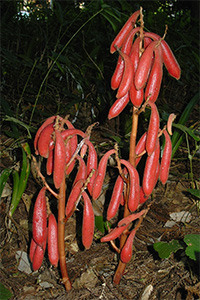
Dr Suetsugu
Dr Kenji Suetsugu, assistant professor of the Hakubi Center, Kyoto University announced avian seed dispersal in the mycoheterotrophic orchid, Cyrtosia septentrionalis .
Unlike most plants, all of the >22,000 species of orchids are heterotrophic in their early life history stages, obtaining resources from fungi before the production of photosynthetic leaves. Orchid seeds, therefore, contain minimal energy reserves and are numerous and dust-like, which maximizes the chance of successful encounter with fungi in the substrate. Despite considerable interest in ways by which orchid flowers are pollinated, little attention has been paid to how their seeds are dispersed, owing to the dogma that wind dispersal is their predominant strategy. In addition, animal seed dispersal has been implicated in a few orchid genera that produce fleshy fruits, but a compelling demonstration has hitherto been lacking.
However, recent, intensive study by motion sensor-equipped cameras in Shiga Prefecture, Japan revealed that their pulp was frequently eaten by four species of birds, with Hypsipetes amaurotis being the most frequent pulp consumer. Suetsugu also directly observed defecation by H. amaurotis in the field and confirmed through examination of the faecal pellets that H. amaurotis ingested C. septentrionalis seeds and thus were not consuming the pulp alone. About half of the seeds sampled from H. amaurotis faeces were viable, a figure that is comparable to the seeds taken directly from intact C. septentrionalis fruits.
Seed dispersal by wind is thought to be successful in open habitats and less efficient in the understory of densely vegetated forests, where wind is less dependable. Cyrtosia septentrionalis is a fully mycoheterotrophic orchid that has lost its ability to photosynthesize throughout its life and, instead, depends entirely on fungi for its nutritive needs. Because mycoheterotrophic plants do not require light, this form of life has allowed them to succeed in the dark forest understory where there are few autotrophic competitors. Thus, a shift to bird dispersal may have facilitated the colonization of such an environment.
The gross fruit morphology and pigmentation patterns of other members of Cyrtosia parallel those seen in C. septentrionalis , suggesting that avian seed dispersal is widespread among the genus Cyrtosia . In addition, fleshy, indehiscent fruit have also been documented in Rhizanthella , a distantly related genus that has also independently evolved full mycoheterotrophy. Some species of Vanilla, although not full mycoheterotrophs, also have seeds with lignified testa and fleshy fruits, which are also considered to be dispersed by animals. Thus, shifts in seed dispersal mechanisms may have played a more significant role in promoting the ecological success and morphological diversity of orchids than previously thought.

A mycoheterotrophic orchid Cyrtosia septentrionalis , which utilizes birds as seed dispersal agents
Paper Information
[DOI] http://dx.doi.org/10.1038/nplants.2015.52
[KURENAI Access URL] http://hdl.handle.net/2433/197830
Kenji Suetsugu, Atsushi Kawakita & Makoto Kato
"Avian seed dispersal in a mycoheterotrophic orchid Cyrtosia septentrionalis"
Nature Plants 1, Article number: 15052 Published online 05 May 2015





